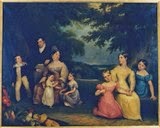The University has a very large Quaker collection, and these
portraits relate to the Ford family, a wealthy Quaker family of the Victorian
era. They intermarried with the Leeds branch of the Pease family, prominent industrialists
in the wool trade. The Leeds Peases are here on Wikipedia, under ‘more distant
relations’. http://en.wikipedia.org/wiki/Pease_family
Once I found the list for the collection in EMu, I started to
piece together exactly who these people were and the important part they played
in Leeds' history, and have been researching where I can ever since. Here
is the entire list, with my notes on it - you'll have to zoom in, and apologies to anyone colour blind! The objects I’ve found are in
red and my additions are in purple.
Incidentally, when I was volunteering, one of my tasks was to write lists like
this!The object that has most intrigued me is the family portrait (xi) – actually the ‘Pease Family Portrait’. We have a black-and-white photograph of this, with a letter attached written by Marian Pease, the daughter of the young boy in the photograph, Thomas Pease. (Marian is mentioned on the Wikipedia page as an ‘educator’, though I don’t know in what capacity.) This letter names everyone in the portrait and details some of Marian and her father’s memories of the Pease sisters. I am now dying to find out where the original is. Even if it’s in a private collection, I just want to know! An image of it has been contributed on ancestry.co.uk and I have decided to become a paying member just so I can look up the Pease and Ford family tree and try and trace the portrait! Until then, only my line manager can log me in, so this image of the portrait is small (as it’s taken from a thumbnail). I’ll replace it when I can.
was the mother of Isabella Ford, the social reformer, and
Emily Ford, the artist, two amazing women I can’t believe I’ve only just
discovered now. Read about them here:
However, I feel a lot of sympathy for the youngest daughter in the portrait, Jane.
She is described as 'mentally deficient' and was institutionalised at various times during her life.
Apparently the Fords of Adel were a radical family who
supported societal reform – very unusual for their class. They also believed in
gender equality: definitely my kind of people!
The other portrait that really interests me is an older,
early 18th century print of Christopher Rawlinson, a descendant of
the Fords. He was an aristocrat from Essex who went to live at Cark Hall in
Lancashire and spent his days editing Anglo-Saxon texts.
The National Gallery holds more of the same print; here is
the image from their website:
Unfortunately, the one we have is the picture I referred to
last time, that has been eaten away by silverfish! If you can imagine, those nasty
critters have left all the black parts (as they don’t like eating ink) and have
taken big patches out of the white parts, namely his face. He looks like he has had a bad case of peeling after sunburn.
On the back of the
frame is a label with some manuscript in Latin; I had to go and ask the two
people in the office who were fluent in Latin to help me decipher it, except
that it confused them as well. Eventually I found out that the text was taken
from the frontispiece of Rawlinson’s book.
It’s so interesting researching these people – I just have
to make sure it doesn’t distract me too much from doing my surveys!






